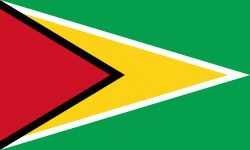East Berbice-Corentyne (East Berbice-Corentyne Region)
East Berbice-Corentyne (Region 6) is one of ten regions in Guyana covering the whole of the east of the country. It borders the Atlantic Ocean to the north, the Nickerie District and Sipaliwini District of Suriname to the east, Brazil to the south and the regions of Mahaica-Berbice, Upper Demerara-Berbice, Potaro-Siparuni and Upper Takutu-Upper Essequibo to the west.
Towns in the region include New Amsterdam, Corriverton and Rose Hall.
The Corentyne River forms the whole of the eastern border with Suriname, though the southernmost section is disputed territory known as the Tigri Area.
The Government of Guyana has administered three official censuses since the 1980 administrative reforms, in 1980, 1991 and 2002. In 2012, the population of East Berbice-Corentyne was recorded at 109,431 people. Official census records for the population of East Berbice-Corentyne are as follows:
* 2012 : 109,431
* 2002 : 123,695
* 1991 : 142,541
* 1980 : 152,386
Towns in the region include New Amsterdam, Corriverton and Rose Hall.
The Corentyne River forms the whole of the eastern border with Suriname, though the southernmost section is disputed territory known as the Tigri Area.
The Government of Guyana has administered three official censuses since the 1980 administrative reforms, in 1980, 1991 and 2002. In 2012, the population of East Berbice-Corentyne was recorded at 109,431 people. Official census records for the population of East Berbice-Corentyne are as follows:
* 2012 : 109,431
* 2002 : 123,695
* 1991 : 142,541
* 1980 : 152,386
Map - East Berbice-Corentyne (East Berbice-Corentyne Region)
Map
Country - Guyana
 |
 |
| Flag of Guyana | |
The region known as "the Guianas" consists of the large shield landmass north of the Amazon River and east of the Orinoco River known as the "land of many waters". Nine indigenous tribes reside in Guyana: the Wai Wai, Macushi, Patamona, Lokono, Kalina, Wapishana, Pemon, Akawaio and Warao. Historically dominated by the Lokono and Kalina tribes, Guyana was colonised by the Dutch before coming under British control in the late 18th century. It was governed as British Guiana, with a mostly plantation-style economy until the 1950s. It gained independence in 1966, and officially became a republic within the Commonwealth of Nations in 1970. The legacy of British rule is reflected in the country's political administration and diverse population, which includes Indian, African, Indigenous, Chinese, Portuguese, other European, and various multiracial groups. In 2017, 41% of the population of Guyana lived below the poverty line.
Currency / Language
| ISO | Currency | Symbol | Significant figures |
|---|---|---|---|
| GYD | Guyanese dollar | $ | 2 |
| ISO | Language |
|---|---|
| EN | English language |















